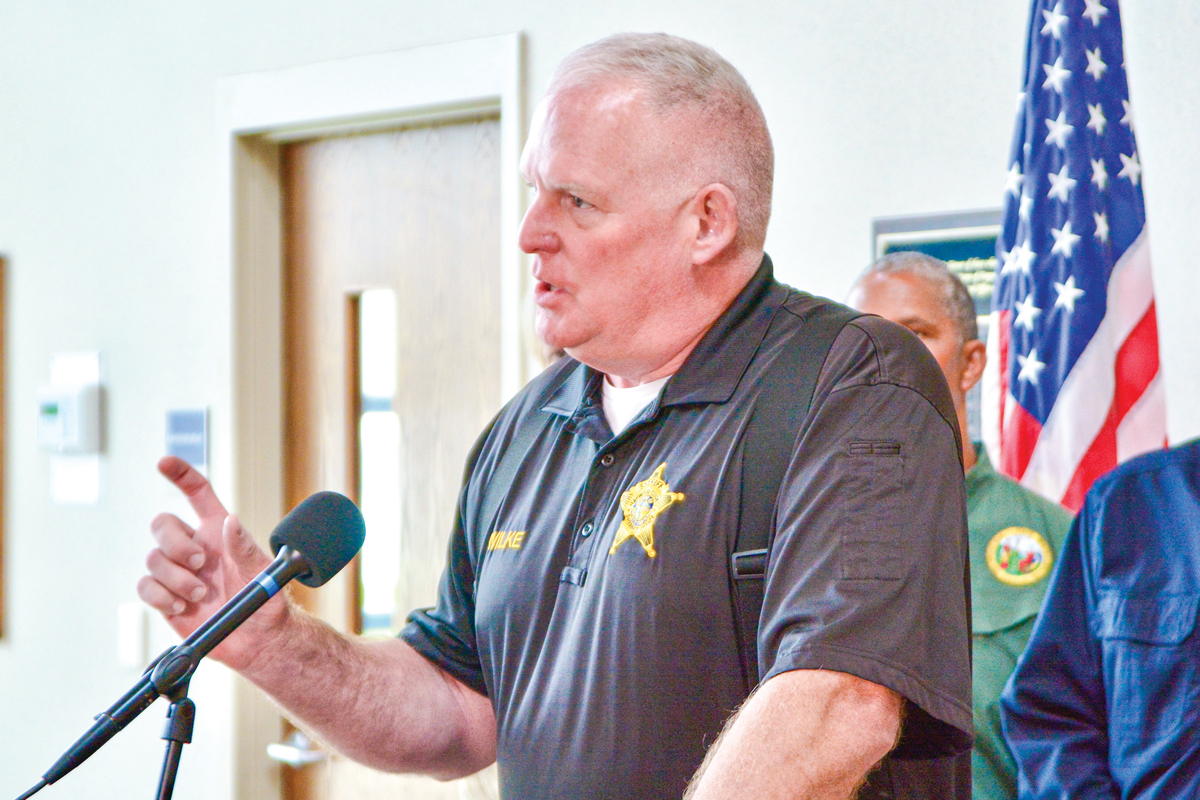Falsehoods vs. facts: Debunking lies about Helene
 “Get off Facebook, and get out there and put on a pair of boots and pair of gloves and get to work. And make it count.” — Haywood County Sheriff Bill Wilke speaks at an Oct. 4 press conference. Cory Vaillancourt photo
“Get off Facebook, and get out there and put on a pair of boots and pair of gloves and get to work. And make it count.” — Haywood County Sheriff Bill Wilke speaks at an Oct. 4 press conference. Cory Vaillancourt photo
Let’s not sugarcoat it anymore. To call it “misinformation” is, in itself, misinformation. Let’s just call it what it is — straight-up lies, of the sort that would earn you a whoopin’ by meemaw if you repeated them to her face instead of spreading them from behind a keyboard like a coward.
Sen. Kevin Corbin’s, R-Franklin, brave stance in an Oct. 3 Facebook post ignited the fight against these lies, garnering national notice and prompting other public officials, both Democrats and Republicans, to speak out against them as well. But the social media cesspool continues to vomit up these smears against administrators, elected officials, FEMA, first responders, journalists, members of our nation’s armed forces and civilian volunteers — all people playing their own small parts to minimize human suffering.
Fight falsehoods with facts.
FALSE: Only $100 million in aid has been provided to Western North Carolina.
FACTS: On Oct. 5, Vice President Kamala Harris announced the administration had made $100 million available to start the process of repairing Interstate 40. But Harris never said that was the end of federal dollars coming to North Carolina. It will likely cost more — much more — to fix I-40 and will take months or years. The day before Harris’ announcement, FEMA announced that it had already helped thousands of survivors with $45 million in “flexible, upfront funding.” Regionally, more than 11.5 million meals, 12.6 million liters of water, 150 generators and 400,000 tarps had been distributed by 5,600 federal workers, including 1,500 from FEMA. In North Carolina, at least $17 million in housing and other assistance has been disbursed to 10,000 households with more than 575 FEMA staff on the ground alongside 38 state and federal search and rescue units and over a thousand National Guard members that have rescued or supported 2,500 people.
A “keyboard warrior” who emailed every member of the General Assembly alleging that the government had done nothing earned a pointed response from Rep. Mark Pless (R-Haywood), according to a story by Thomas Mills for PoliticsNC: “I don’t know who you think you’re talking to but for your uninformed stance I have news. As a water rescue tech I was in the water at 6 am rescuing people from their homes. I spent all day Friday pulling people from cars that drove into flood barricades and getting people from houses that were surrounded by water. Then the remainder of the time until this moment coordinating supplies to help my two communities access what they needed. During all this time you watched TV in the safety of your home while the governor of another state talked about his situation. Did you ever stop long enough to consider we aren’t saying anything because we are in the trenches fighting to help our residents live through this time?”
Related Items
FALSE: FEMA is running low on cash.
FACTS: Homeland Security Secretary Alejandro Mayorkas just can’t stop making ridiculous statements — about the border and about FEMA. While he did say FEMA doesn’t have enough funding to make it through hurricane season, he also said that FEMA is “meeting the immediate needs with the money that we have,” according to the Associated Press. Traditionally, FEMA’s Disaster Relief Fund (DRF) is funded with a baseline appropriation each year, and as disasters small and large occur, Congress provides supplemental appropriations in the tens of billions of dollars as needed. As of Aug. 31, FEMA had $3.4 billion, but two days before Helene hit, Congress dropped in with another $20 billion. In 2005, a trio of hurricanes including Katrina pushed that supplemental appropriation above $90 billion.
FALSE: FEMA is running low on cash because they gave it all away to unauthorized migrants.
FACTS: The claim is laughably false. FEMA manages the Disaster Relief Fund (DRF), which consists of those baseline and supplemental appropriations; FEMA also manages the Shelter and Services Program (SSP), which provides humanitarian services to noncitizen migrants so they don’t overburden state and local governments. While some may disagree with the policy goals of the SSP, the DRF and SSP utilize separate funding streams that cannot be intermingled; SSP cannot be used for disasters, and DRF cannot be used for migrants. Additionally, in 2024 the SSP program received $641 million in funding, according to the Congressional Research Service, which ends up being a tiny fraction of what the DRF receives.
FALSE: FEMA is running low on cash because they gave it all away to Lebanon and Ukraine.
FACTS: On Oct. 4, Secretary of State Antony Blinken announced nearly $157 million in humanitarian assistance to Lebanon in the face of regional conflict. The funding comes not from FEMA but rather from the U.S. Department of State. Ditto for Ukraine, which has received approximately $150-175 billion in assistance since February 2022 — none of which has come from FEMA’s DRF. Interestingly, much of the assistance provided to Ukraine has gone to American weapons manufacturers, employing Americans and donating weapons to Ukraine. Other segments of assistance have come directly from Department of Defense stockpiles. Again, some may disagree with federal policy goals pursued by providing basic necessities to Lebanon and more robust support to Ukraine, but no one can say it’s taking away from Hurricane Helene relief efforts in the Southeastern United States.
FALSE: FEMA has only been giving people impacted by the storm $750, but it’s a loan.
FACTS: These $750 payments are called “serious needs assistance” and are meant to address only immediate concerns, like toiletries and nutrition. Other individual assistance aid available to eligible individuals and households include lodging reimbursement, rental assistance, home repair, accessibility assistance for people with disabilities, medical assistance for the injured, unemployment assistance and miscellaneous assistance, like money for generators, dehumidifiers and even chainsaws. They are not loans, however some may have to be paid back if people filed duplicate claims or also received reimbursements from private insurance policies. As the name suggests, individual assistance programs aren’t the only forms of FEMA assistance available to people impacted by disasters. Many individuals will qualify for other assistance based on the nature and extent of their damages. Then, there’s the “public assistance” programs, that make grants to governments for road and bridge repair, debris removal and utility and water system restoration.
FALSE: Airspace has been closed by federal authorities, hindering both public and private recovery operations.
FACTS: To the contrary, rural Western North Carolina’s airspace has probably never been more crowded. Military helicopters landing in parks, small private aircraft and helicopters bringing in supplies and drones filming the damage, all alongside regular commercial passenger operations have resulted in a 300% increase in traffic, according to the North Carolina Division of Aviation. To ensure safe operations, the FAA can issue Temporary Flight Restrictions (TFRs) on airspace, meaning civilians and volunteers must first coordinate with emergency responders, however as of Oct. 6 there were none. The FAA can also designate Airspace Coordination Areas (ACAs), which do not restrict operations but advise pilots of unusual conditions — in this case, congestion. An ACA is currently in place over Western North Carolina. Another tool the FAA is using to ensure safe operations is Prior Permission Requests (PPRs), which require pilots to call ahead and confirm landing and unloading times to avoid dangerous congestion on the ground. PPRs are currently in place at Asheville Regional Airport, Rutherford County Airport and Foothills Regional Airport near Morganton. Rep. Mike Clampitt, a Swain County native, said in a Facebook post on Oct. 5 that from what he knew of Transylvania County, rumors of FAA interference in relief operations weren’t true. For more information, visit the North Carolina Division of Aviation at connect.ncdot.gov/municipalities/state-airport-aid/pages/helene.aspx.
FALSE: The government is seizing the town of Chimney Rock, which was largely destroyed.
FACTS: Rutherford County Emergency Management had to take time away from its important work on Oct. 3 to post a substantial rebuttal to outrageous “land grab” allegations on Facebook. Rutherford EMS called the claims, as well as claims of “bodies everywhere” — only three confirmed fatalities as of Oct. 7 — as “entirely false.”
FALSE: Rep. Marjorie Taylor Greene (R-GA) tweeted that “they” can control the weather.
FACTS: If you need someone to debunk this for you, well, you probably won’t believe the facts once they’re presented to you anyway. It’s unknown who, exactly, Greene means by “they,” although it’s presumably Democrats, or Jews, who she accused of starting California wildfires in 2018 with space lasers. Plus, if the hurricane was engineered or directed by liberals to interfere with the election, why was the epicenter in North Carolina’s most liberal city, Asheville?
FALSE: FEMA is obstructing or confiscating privately-supplied aid and donations.
FACTS: “Donations are not being confiscated by state and federal officials,” according to NCDPS. In fact, the Tennessee Emergency Management Agency and North Carolina Gov. Roy Cooper’s office are both actively soliciting donations. Visit nc.gov/donate to learn more, or find your local United Way online.
FALSE: Roadblocks are turning away supplies and volunteers.
FACTS: Roadways are still dangerous in some parts of Western North Carolina; in a few places, traffic is being re-routed to preserve access for first responders, per NCDPS.
(For more information on rumors related to Hurricane Helene, visit FEMA’s rumors page at fema.gov/disaster/current/hurricane-helene/rumor-response or the North Carolina Department of Public Safety’s rumors page at ncdps.gov/our-organization/emergency-management/hurricane-helene-fact-vs-rumor.)













